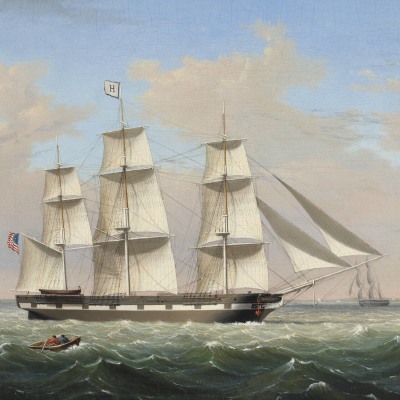
(1804–1865)
Fitz Henry Lane was born in Gloucester, Massachusetts, a descendent of a family of fishermen that had resided on Cape Ann since 1623. Paralyzed from infancy, Lane taught himself how to draw and paint and spent countless hours honing his technique. By the age of twenty-eight, he was hired to apprentice at Pendelton’s Lithography, the most important printmaking firm in Boston. Here he was exposed to other American and European artists, including British marine specialist Robert Salmon.
Lane soon enjoyed success as both a painter and printmaker. By the 1840s his sale of oil paintings increased, which in turn diminished the need to rely on income from his lithographs. In 1841 Lane first exhibited at the Boston Athenaeum an oil painting entitled Scene at Sea, and in March 1842 he exhibited Ships in a Gale at the Apollo Association in New York City. By 1847, Lane’s reputation was firmly established, and he moved back to Gloucester permanently, except for trips to New York, Maine, Maryland, and possibly Puerto Rico. His highly refined images of Gloucester Harbor and its environs were celebrated for their minute detail and crisp delineations of form.
During the late 1850s Lane simplified his works, painting thinly and eliminating detail in order to focus on effects of light and create a tranquil mood.[1] “Lane was more radical in his coastal scenes, from which, during the 1850s, he successively purged genre and topographical elements, so much so that, together with Martin Johnson Heade, he may well be considered the true avant-garde of American mid-century landscape painting.”[2] Lane’s mature work greatly influenced the second generation of Hudson River School artists such as John F. Kensett, Frederic E. Church, and Heade, who were forming their own luminist styles around the same time.[3]
Lane exhibited his work at the National Academy of Design in 1859 and at galleries in Boston, Gloucester, and Albany. His work is found in esteemed private collections and major museum collections, including The Metropolitan Museum of Art and Brooklyn Museum, New York; National Gallery of Art and Corcoran Gallery of Art, Washington, D.C.; Carnegie Institute, Pittsburgh; Nelson-Atkins Museum of Art, Kansas City; Amon Carter Museum, Fort Worth; and the Thyssen-Bornemisza Museum of Art, Madrid. The Cape Ann Historical Association and the Museum of Fine Arts, Boston, have large collections of Lane’s work.
[1] John Wilmerding, Fitz Hugh Lane (New York: Praeger Publishers, 1971), 75.
[2] John Caldwell and Oswaldo Rodriquez Roque, American Paintings in the Metropolitan Museum of Art, vol. 1 (New York: Metropolitan Museum of Art, 1994), 492.
[3] Wilmerding, Lane, 79.
